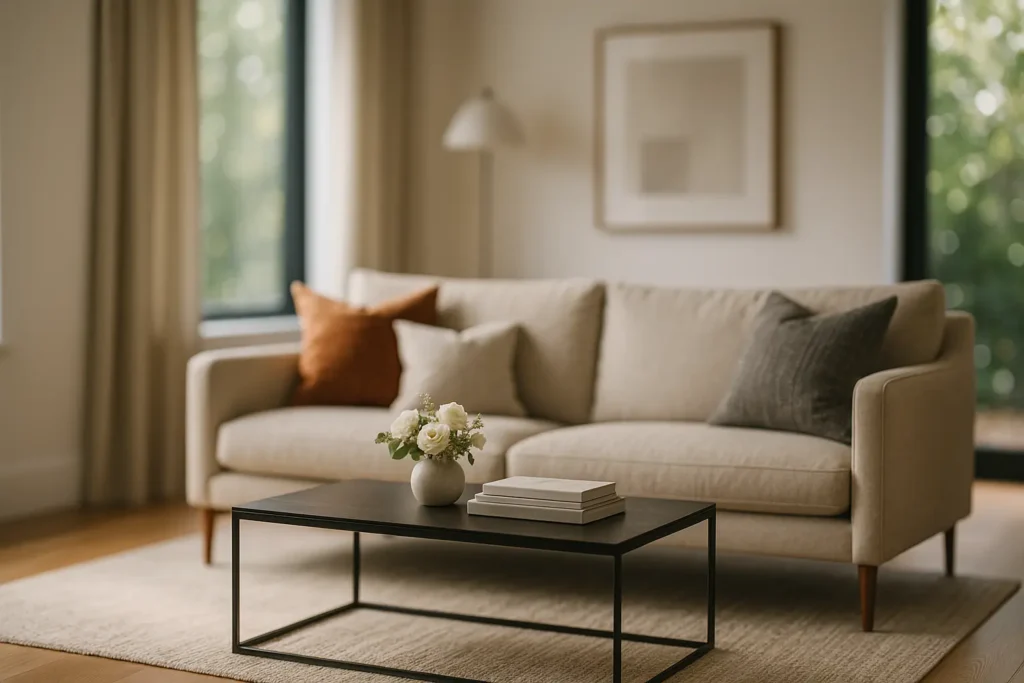In today’s dynamic world of interior design, crafting an inviting and aesthetically pleasing living space has become both an art and a science. With inspiration at our fingertips, thanks to platforms like Instagram and Pinterest, the possibilities for reinventing our rooms are endless. However, transforming an ordinary space into an extraordinary one requires a blend of creativity and strategy. As we navigate the nuances of design, it brings us joy to share insights from top designers who have mastered the art of revitalizing homes. In this article, we’ll delve into five decorating hacks that will empower you to breathe new life into your interiors. Armed with these expert tips, you can elevate your living space from mundane to magnificent.
1. Embrace the Power of Color
When it comes to interior design, the strategic use of color can dramatically alter the mood and perception of a room. As experienced designers, we’ve witnessed firsthand how a well-chosen hue can transform a space, making it feel larger, cozier, or even more vibrant.
The Psychological Impact of Color
Colors aren’t just decorative; they hold psychological power. Blues and greens promote tranquility, making them ideal for living rooms and bedrooms where relaxation is paramount. Warm hues like reds and oranges invigorate, perfect for spaces like dining rooms and kitchens. By understanding the emotional impact of colors, we can tailor our designs to suit the desired ambiance of each room.
Creating Depth with Color
One effective hack is using contrasting colors to add depth and interest to a space. A bold accent wall can create a focal point, drawing the eye and giving the illusion of depth. For a cohesive look, choose an accent color from the same palette as your main room color but in a darker or more saturated tone.
The Role of White
White is often underestimated, yet it remains a favorite among designers for its versatility. It reflects light, making spaces appear more open and airy, and serves as an excellent backdrop for other decor elements. To avoid starkness, pair white with natural materials like wood or leather, which add warmth and texture.
By wielding the magic of color, we can create spaces that not only look stunning but also resonate with the inhabitants on a deeper level.
2. Furniture Arrangement: Function Meets Aesthetic
In the art of interior design, the way we arrange our furniture significantly impacts both the functionality and visual appeal of a room. It’s not just about placing pieces in a space; it’s about creating a harmonious flow that encourages both use and enjoyment.
Understanding Space and Proportion
Every room presents its unique dimensions and challenges. Our task is to maximize the potential of the space without overwhelming it. A room filled with oversized furniture can feel cramped and unwelcoming, whereas appropriately scaled pieces create balance and harmony. By respecting the proportions of the space, we can design rooms that feel both comfortable and open.
The Art of Zoning
Zoning is a technique top designers frequently employ to create distinct areas within a single room. By strategically placing furniture, we can delineate spaces for lounging, dining, or working, even in open-plan designs. This subtle division not only enhances functionality but also adds an element of order and sophistication.
Fostering Connection
The arrangement of furniture plays a crucial role in encouraging interaction. In living areas, we aim to create intimate seating arrangements that facilitate conversation and connection. Sofas and chairs should be positioned to face each other, with coffee tables providing a central point of focus. This creates a warm, inviting atmosphere that draws people in.
By mastering the principles of furniture arrangement, we can transform any room into a space that is not only visually appealing but also intuitively functional.
3. Wall Decor: Beyond Mere Decoration
Walls offer a blank canvas with endless possibilities to express our personal style and enhance the overall aesthetics of a room. Whether through paint, art, or other decorative elements, our goal is to infuse personality and vibrancy into every space.
The Narrative of Art
Art is more than just an accessory; it tells a story. When selecting pieces for walls, we consider their narrative and how they align with the room’s theme. A large, bold painting can serve as a conversation starter, while a collection of smaller pieces might convey a sense of travel, history, or personal milestones. As designers, we curate collections that reflect the essence and personality of the inhabitants.
Textures and Layers
Incorporating different textures on walls can add depth and interest to a room. From fabric panels and textured wallpapers to exposed brick or wood accents, these elements add a tactile dimension that enriches the overall design. By mixing materials, we create spaces that are inviting and engaging.
The Power of Paint
Never underestimate the transformative power of a fresh coat of paint. Whether opting for a bold hue or a subtle neutral, paint can redefine a space entirely. For a fresh look, consider painting walls with trending colors or experimenting with techniques like ombre or geometric patterns.
With thoughtful wall decor, we can elevate a room from ordinary to extraordinary, making every glance a delight.
4. Lighting: The Unsung Hero of Interior Design
Too often overlooked, lighting is a crucial element in interior design that can make or break the ambiance of a space. As professional designers, we understand that effective lighting not only illuminates but also enhances the mood, functionality, and aesthetic appeal of a room.
Layered Lighting
An essential technique in lighting design is the use of layers. Combining ambient, task, and accent lighting allows us to create rooms that are both functional and visually captivating. Ambient lighting, like chandeliers or recessed lights, provides overall illumination. Task lighting, such as desk lamps or under-cabinet lights, serves specific purposes. Accent lighting highlights architectural features or decorative elements, adding drama and focus.
Playing with Shadows
The interplay of light and shadow can add depth and intrigue to a space. By strategically placing light sources, we can create captivating shadow patterns and focal points. For example, a well-positioned floor lamp can cast an arch of light that accentuates a room’s texture and structure.
The Influence of Fixtures
Lighting fixtures themselves are art pieces that contribute to the design of a room. From minimalist pendants to ornate chandeliers, the style of a fixture speaks volumes about the overall aesthetic. When selecting lighting, we ensure it complements the room’s theme while providing adequate illumination.
With the right lighting strategy, we can breathe life into any space, transforming it into an inviting haven.
5. Personal Touch: The Signature of a Well-Designed Space
In the world of interior design, it is the personal touches that transform a house into a home. As designers, our role is to help clients express their individuality and style through their living spaces.
Curating Meaningful Decor
We encourage incorporating decor that holds sentimental value or personal significance. Whether it’s a family heirloom, a piece collected during travel, or a handmade craft, these items infuse a room with character and warmth. The stories behind these pieces create a narrative that connects the inhabitants to their space.
Celebrating Individuality
Customization is key to making a space uniquely yours. From bespoke furniture to custom paint finishes, personalization adds a layer of exclusivity. By collaborating with top designers and artisans, we can craft one-of-a-kind items that reflect the client’s personality and lifestyle.
The Beauty of Diversity
Incorporating diverse design elements, such as global art, vintage finds, or eclectic accessories, adds depth and richness to a room. By embracing a mix of styles, we create spaces that are vibrant and dynamic, evoking a sense of adventure and discovery.
Ultimately, personalizing a room is about capturing the essence of the individuals who inhabit it. With these tailored touches, a space becomes a true reflection of its occupants.
In the realm of interior design, there are no one-size-fits-all solutions. Each space is a canvas waiting to be painted with your unique vision. By embracing the wisdom of top designers and incorporating these essential decor hacks, we can create rooms that are not only beautiful but also meaningful and personal.
The journey of transforming a space is both exciting and rewarding. As we experiment with colors, arrange furniture, adorn walls, illuminate with purpose, and add our personal touches, we weave a tapestry that reflects our story.
Let us embark on this creative adventure together, crafting living spaces that inspire, comfort, and delight. With each choice, we take credit for shaping a world that is uniquely ours, one room at a time.
FAQ
What are some simple ways to elevate a room’s aesthetic without breaking the bank?
One cost-effective method is switching out your throw pillows. Choosing vibrant patterns or textures can instantly refresh the look of your living space. Additionally, rearranging furniture or adding a splash of paint to a feature wall can make a significant impact.
How can lighting influence the mood and style of a room?
Lighting plays a crucial role in setting the ambiance. Layered lighting, which includes ambient, task, and accent lighting, allows you to adjust the mood to suit different occasions. Using dimmers can also help create a cozy or vibrant atmosphere as needed.
What are some tips for choosing art pieces that complement a room’s design?
Select artwork that harmonizes with the room’s color scheme and overall style. It’s important to consider the size of the artwork in relation to the wall space. Grouping smaller pieces together can create a gallery-like effect, while a single large piece can serve as a focal point.
How can I make a small space feel larger and more open?
Incorporate mirrors to reflect light and create an illusion of more space. Opt for furniture with legs to maintain an airy feel and choose lighter colors for walls and large pieces to enhance the sense of openness.
What is a common mistake people make when decorating, and how can it be avoided?
A frequent mistake is overcrowding a room with furniture and decor. To avoid this, prioritize functionality and ensure there is enough space for movement. Edit your decor by keeping only pieces that serve a purpose or bring joy.



